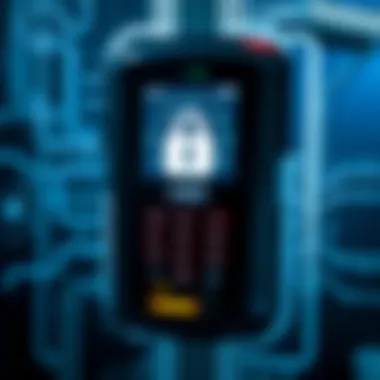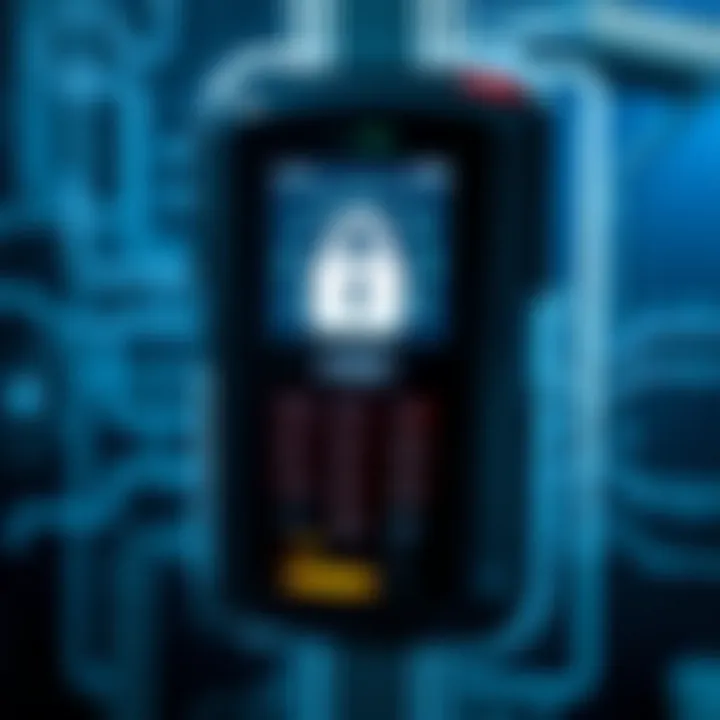In-Depth Insights into the HID Card Reader System


Overview
Prelude to the topic of the article
The HID card reader system serves as a cornerstone in modern security and access control frameworks. As organizations strive to enhance their security measures, the integration of sophisticated technologies like HID provides a bridge to a more reliable access management solution. This system not only governs who has entry to specific areas but also logs such access to create an audit trail, enhancing accountability and monitoring capabilities.
Brief background information
HID Global, founded in 1991, revolutionized proximity card technology, making access control more efficient and user-friendly. Over the years, the company has expanded its suite of products, which now includes a range of card readers that utilize various technologies from proximity and smart cards to mobile access solutions. This evolution aligns with the rapid development of security technologies and the shifting needs of businesses.
Making sense of HID’s architecture, key functionalities, and wisdom in installations can be quite a task for those unfamiliar with such systems. However, understanding these elements is crucial not just for security professionals but for anyone looking to comprehend the complexities of modern access control systems.
Features & Specifications
HID card readers come equipped with several noteworthy features designed to streamline access control:
- Technology Compatibility: HID supports various technologies, including iCLASS, SEOS, and Prox, making it adaptable to different environments.
- Security Features: Implementing encryption and anti-cloning measures ensures that access credentials remain secure.
- User Interface: Most models feature simple LED indicators and audible notifications to guide users seamlessly.
- Integration Capabilities: From security systems to building management systems, HID readers can integrate smoothly, enhancing utility.
Each reader varies in technical specifications such as read and write ranges, operational frequencies, and power requirements, so understanding the specific model is vital when setting up an access control system.
Pros and Cons
When considering HID card readers, it's essential to weigh their advantages against potential limitations:
Advantages:
- High Security: Advanced encryption methods bolster protection against unauthorized access.
- Flexibility and Scalability: Readers can be added or replaced without extensive overhauls of existing infrastructure.
- Durable Design: Built to withstand various environmental conditions, many readers endure outdoor installation.
Disadvantages:
- Cost: Initial prices can be on the higher end compared to traditional methods.
- Complex Installation: Depending on the existing setup, improper installation can lead to issues.
- Dependency on Power: Some readers require constant power, which could be a drawback in case of outages.
User Experience
User impressions highlight the reliability of HID card readers in daily operations. One facilities manager noted, "Since integrating HID systems, we've seen a significant reduction in unauthorized entries, and it's been a game-changer for our security team." Most feedback indicates that the systems are reasonably user-friendly, allowing for quick employee onboarding while providing administrators with a clear view of access logs.
Real-world reviews:
- Efficiency: Users appreciate the quick access times, with many noting only a second or two required for authentication.
- Support Availability: Some customers expressed concern over the waiting times for technical support, suggesting a need for a more responsive service.
Buying Guide
For those contemplating a purchase of HID card readers, consider the following:
- Evaluate Security Needs: Assess the level of security your organization requires. More sensitive environments might benefit from higher-end models with advanced encryption.
- Installation Considerations: Engage with professionals if unsure about installation; poor setup can undermine security effectiveness.
- Long-term Value: Look beyond the upfront cost; factor in how the reader will fit into your long-term security strategy.
For more in-depth information, you can refer to resources like Wikipedia or delve into discussions on Reddit.
By taking these elements into account, one could find that investing in HID technology not only meets immediate security needs but also sets the stage for future enhancements.
Understanding HID Card Reader Systems
The landscape of access control is perpetually evolving, placing an emphasis on security and efficiency. Understanding HID card reader systems is an indispensable step in grasping how modern security solutions function. The significance of these systems transcends basic access – they offer a blend of technology, usability, and security that is crucial in today’s world of heightened threats.
Foreword to Access Control Systems
Access control systems are the backbone of security frameworks in both commercial and residential spaces. These systems regulate who can enter specific areas at given times. By managing entry points, they diminish the risks associated with unauthorized access, theft, and vandalism. A well-designed access control system contributes to not only protecting physical assets but also safeguarding sensitive data and individuals.
HID, or Identification Hardware Incorporation, has carved a niche in this field by providing reliable products that enhance security. As technology grows more sophisticated, so too does the approach to security systems. Integrating features such as mobile access, biometric verification, and remote management makes access control not just functional but also adaptable.
One pivotal element in these systems is the reader, which serves as a gatekeeper for entry. From understanding how the readers interact with credentials to recognizing their pivotal role in the broader security schema, it is important to grasp how these devices operate.
What are HID Card Readers?
HID card readers are devices that allow information retrieval from a specific credential, which could be a card, fob, or even a mobile phone. These readers utilize electromagnetic fields, radio frequencies, or contact mechanisms to gather data. Once they relay this information to a host system or controller, authorization decisions are typically made instantly, allowing or denying access based on predefined parameters.
The appeal of HID card readers lies in their versatility. They are available in various forms, catering to the needs of diverse organizations ranging from corporate offices to hospitals. By employing both contact-based and contactless identification methods, HID offers a balance between security and convenience.
For example, in health facilities, unauthorized access can pose serious risks. Healthcare professionals, thus, often rely on HID systems to ensure that only authorized personnel are able to retrieve sensitive patient data or access restricted areas. In such cases, the practicality of HID card readers is clearly illustrated.
Through continuous advancements in technology, HID has expanded its range to include mobile credential systems, enabling users to present digital credentials via smartphones, which brings functionality right into users’ pockets. Understanding these readers invites an exploration into how they have laid the groundwork for seamless integration of security measures and user-friendly access solutions.
Architecture of HID Card Readers
The architecture of HID card readers forms the backbone of how these systems operate within access control environments. It details the structure and organization that make up these devices, encompassing everything from the physical components to the protocols guiding their communication. Understanding this architecture is crucial for tech enthusiasts and professionals alike, as it sheds light on the capabilities and limitations of these systems. Additionally, a well-designed architecture helps to ensure security, compatibility, and ease of integration with other systems.
Components of the System


At the core of every HID card reader system are its key components. Each serves a specific function, and together they create a cohesive access control environment.
- Reader Unit: This is the first point of interaction. This device handles the actual reading of the cards, whether they are contact or contactless. Many units are designed to be mountable on walls or integrated within modular systems.
- Access Control Panel: Often the unsung hero, this panel manages the entire access process. It processes the data from the reader and determines whether access should be granted or denied based on preconfigured rules.
- Database: A back-end database stores user credentials and transaction logs. It can provide historical data that may help in auditing security breaches or unauthorized attempts to access restricted areas.
- Power Supply: Given that card readers often run continuously, reliable power sources are vital. Some systems use Power over Ethernet (PoE), simplifying wiring and installation.
- Networking Elements: Network connectivity allows for communication between different components, and exposes them to software interfaces needed for managing access controls.
In many ways, these components reflect a delicate balance between usability and security; a system that is too complicated may deter legitimate users whilst leaving doors open for unauthorized access. This harmonious design is what gives HID systems their robustness.
Communication Protocols
Communication protocols play a fundamental role in the architecture of HID card readers. They dictate how data exchanges occur, ensuring that information flows smoothly between the reader and the control systems.
- Wiegand Protocol: One of the most widely used protocols, Wiegand is recognized for its reliability in transmitting card data. It consists of various bit patterns, making it efficient for the reader to send information to the control panel.
- RS-485: This protocol is known for its longer transmission distances and ability to connect multiple devices along a single line. It’s ideal for larger systems that span considerable areas, such as corporate campuses.
- TCP/IP: This protocol takes communication a step further, enabling card readers to connect to network infrastructures just like any computer. This allows for remote management and central monitoring.
"Understanding the communication protocols is essential, as they affect the speed and efficiency of data processing in HID systems."
In today's digital age, where security is paramount, the right selection and implementation of these protocols can significantly enhance the overall functionality and security of HID card reader systems. By ensuring these components are well-integrated and communicate effectively, organizations can build a more resilient electronic access framework.
HID Card Reader Types
HID card readers are essential components of modern access control systems, and understanding their types is crucial for any organization aiming to bolster security. These types cater to different security needs and operational environments, offering various functionalities and features.
Contactless vs. Contact Types
When considering HID card readers, one of the biggest distinctions to note is between contactless and contact types.
Contactless Readers
Contactless HID card readers are like the smooth operators of the access control world. They use radio frequency identification (RFID) technology to communicate with cards without the need for physical contact. Users simply wave their cards near the reader, which can be immensely convenient in high-traffic areas. These readers often have faster transaction times since there's no need to fumble around with physical connections.
- Benefits of Contactless Readers:
- Faster user access, as there’s no need to insert cards.
- Reduced wear and tear on cards and readers because they don’t physically touch.
- Enhanced hygiene since users won't have to physically touch surfaces closely, a crucial advantage in healthcare settings.
Yet, while these come with great perks, they also have considerations. For instance, they often require more advanced security features to protect against relay attacks, where a malicious actor could potentially mimic a card.
Contact Readers
On the other side, contact HID card readers demand physical insertion or touching of the card. Often considered "vintage" in the tech realm, they still serve vital roles in environments where heightened security is paramount. These readers can be integrated with smart cards that contain embedded chips, adding additional layers of security.
- Benefits of Contact Readers:
- They usually offer robust security measures, thus being favored in high-security environments.
- Simpler technology often leads to lower costs in some situations.
Hence, when evaluating which type to deploy, one must consider the environment’s specific security requirements, the flow of traffic, and user convenience.
Mobile Credentialing
With the advancement of technology, mobile credentialing has begun to reshape the landscape of HID card readers. Gone are the days when one’s access was limited to a plastic card in a wallet. Nowadays, many organizations are looking at utilizing smartphones as secure access tools.
Mobile credentialing typically employs compatible smartphones that can store access credentials and interact with card readers via Bluetooth or similar secure technologies. This offers a noticeable convenience factor—employees can simply tap their phones, cutting down on the hassle that accompanies carrying multiple cards.
- Advantages of Mobile Credentialing:
- Convenience: Users are likely to always have their phones with them, making access quicker and easier.
- Cost-Effectiveness: Reduces the need for a physical card issuance system, which can be quite expensive in the long run.
- Enhanced Security: Mobile devices come with various security features, such as biometric locks and remote wipe capabilities, helping to safeguard sensitive access credentials.
Installation and Configuration
The process of installation and configuration of HID card reader systems is a crucial phase that sets the stage for optimal operations within an access control framework. This stage is not merely about placing a device in a particular location; it involves detailed planning, troubleshooting potential issues, and ensuring all components function harmoniously. A poorly executed installation can lead to security breaches and inefficiencies that undermine the system's intended purpose. Therefore, understanding the elements involved is vital for tech enthusiasts and professionals alike.
Planning the Installation
Before kicking off the actual installation, a thorough plan must be chalked out. This involves evaluating the physical layout of the premises, assessing potential entry points, and deciding on the ideal positioning of the card readers. Additionally, it’s essential to consider factors such as:
- Security Threats: Analyze areas that may attract unauthorized access. Identify where a card reader could deter unwanted visitors effectively.
- User Traffic: Anticipate the flow of people using the card reader. High-traffic zones may require more advanced systems to handle the load efficiently.
- Environmental Conditions: Weather exposure can affect performance. For instance, an outdoor card reader needs robust weatherproofing to guard against harsh elements.
Creating a detailed plan beforehand can save time and resources down the road. It’s advisable to sketch out a map highlighting reader locations, wiring paths, and network connection points to get a clearer picture of the installation process.
Wiring and Setup
Once planning is neatly tucked away, it's all hands on deck for the actual installation. A common rookie mistake is to overlook the wiring layout, which can lead to a host of complications. Proper wiring is the lifeblood of any HID card reader system.
When setting up wiring, consider the following:
- Cable Types: Choose the right cables suited for the specific HID card reader model and environment. For instance, shielded cables are often recommended in industrial settings to minimize interference.
- Length and Routing: Ensure cables are not excessively long to avoid voltage drop. Also, try to route them through secure channels to ward off tampering.
- Power Supplies and Connectivity: Ensure that the local power supplies can handle the demand placed by card readers and any associated components. Establishing a stable connection to the network is equally important to facilitate real-time communication.
After ensuring the wiring is correctly laid out, proceed with the setup of the equipment. This typically involves:
- Mounting the Readers: Depending on the type, readers can be surface-mounted or recessed into walls. Secure them firmly to prevent physical tampering.
- Configuring System Settings: Before booting up, input crucial information into the system—this may include configuring encryption settings and user credentials.
- Testing: After installation, it’s essential to run a series of tests ensuring everything works as intended. Check if the card reader interacts correctly with the backend system and assess response times.


In wrapping up the installation and configuration, it is vital to document every step taken. This documentation can serve as a reference for future maintenance or troubleshooting and helps to keep all stakeholders informed about the system's components.
"Effective installation is less about following manuals and more about understanding intricacies. With a bit of foresight, many future hiccups can be avoided."
Security Features of HID Card Readers
In the domain of access control, security features hold paramount importance. HID card readers don't just facilitate entry; they also fortify the overall security architecture of any facility. With an increasing number of threats—both digital and physical—understanding the security elements embedded within HID systems is crucial. This section delves into two primary aspects: Encryption Standards and Tamper Detection Mechanisms. Together, these components bolster the reliability and safety of the HID card reader systems.
Encryption Standards
Encryption is the gatekeeper of data integrity and confidentiality. HID card readers widely utilize advanced encryption protocols to safeguard sensitive information transmitted during access transactions. This ensures that data, such as personal identification credentials, cannot be easily intercepted or deciphered by unauthorized parties.
HID employs several standard encryption methods, including:
- AES (Advanced Encryption Standard): Known for its robustness, AES is a favored choice in many security applications. It utilizes varying key lengths (128, 192, or 256 bits) to increase the difficulty of decryption.
- DES (Data Encryption Standard): Although largely considered outdated compared to AES, some legacy systems still use DES. This standard encrypts data in 64-bit blocks but is generally less secure by modern standards.
- RSA (Rivest-Shamir-Adleman): Typically utilized for secure data transmission, RSA is a public-key encryption method that allows secure sharing of keys over unsecured channels.
Utilizing these encryption standards provides numerous benefits, such as:
- Protection against unauthorized access: By encoding the data, attackers face significant hurdles in trying to access sensitive information.
- Data integrity assurance: Encryption helps ensure that the information remains unaltered during transmission.
- Enhanced user trust: Knowing that their data is secure builds client confidence in the security measures implemented.
"Security isn't just a necessity; it’s a necessity for peace of mind."
Tamper Detection Mechanisms
Equally crucial to the security profile of HID card readers are tamper detection mechanisms. These safeguards act like a safety net, alerting administrators when any unauthorized access attempts occur. Tamper detection ensures that even if a device is compromised physically, the system can either lock down or notify security personnel.
Mechanisms include:
- Tamper Switches: Installed within the reader, these switches trigger an alarm or lockdown mode if someone attempts to open the unit or detach it from its mounting.
- Surveillance Integration: Some readers can interface with monitoring systems, which keeps an eye on physical security measures. A suspicious action could send a signal to alert security personnel instantly, enabling a quick response.
- Event Logging: Many systems log access attempts, including both successes and failures. This data trail can be invaluable for reviewing incidents and figuring out any loopholes.
The main takeaway here is that tamper detection mechanisms serve to:
- Deter potential intrusions: Knowing the system has security features in place may discourage would-be thieves.
- Facilitate quick response: Immediate alerts allow for faster intervention, potentially limiting damage.
- Provide accountability: Data logs ensure there's a record of interactions, making it easier to investigate any irregularities.
Integration with Other Systems
Integrating HID card reader systems with other technological frameworks is a cornerstone of modern access control setups. This integration often leads to enhanced efficiency and security. In today's interconnected environment, just having a standalone access control system is not enough. Organizations are looking for ways to synchronize various control elements to form a cohesive security network, which serves to mitigate risk while providing seamless user experience.
One of the fundamental aspects of integration involves ensuring compatibility with existing hardware and software infrastructures. Organizations often utilize various platforms for security management, and having an HID card reader that can interact with these platforms helps to unify the security protocols across multiple access points. The flexibility in access control software means that HID solutions can cater to a broad range of operational needs.
Compatibility with Access Control Software
When we talk about compatibility with access control software, it’s vital to understand that different software platforms offer varying levels of functionality and user interfaces. HID card readers can integrate with top-tier software, allowing for real-time monitoring, user management, and reporting functionalities to streamline operations. Major software systems such as Lenel S2, AMAG Technology, and Genetec have the capability to work hand-in-hand with HID readers, thus providing a more rounded security solution.
Moreover, the ease of integration with access control software can reduce training time for personnel. Having a user-friendly interface simplifies operation. This thoughtful approach in design means that both experienced security professionals and newcomers can navigate the system with a relative ease, making the whole security architecture more robust.
Some of the high-level benefits of this integration include:
- Centralized Control: Users can manage multiple sites from a single platform.
- Scalability: Organizations can easily add new card readers or locations without overhauling the system.
- Enhanced Data Tracking: Integration allows for better analytics, helping to optimize security routines.
Interfacing with Alarm Systems
Integrating HID card reader systems with alarm systems is another vital juncture in achieving comprehensive security management. This combination enhances responsiveness and allows for quicker reaction times in case of unauthorized access events.
When an unauthorized individual tries to gain entry, a card reader can not only deny access but also trigger alarms that alert security personnel instantly. This harmonious interaction greatly increases the effectiveness of an organization’s security protocol.
An integrated system can also utilize alarm systems to auto-lock doors if a breach is detected or send real-time notifications to security staff via mobile devices. The seamless integration is made possible because most modern alarm systems support standardized communication protocols like TCP/IP or even Z-Wave technology for wireless data transfer.
Some critical features to look for in interfacing options include:
- Real-time Communication: Instant alerts reduce response time and enhance overall security.
- Unified Monitoring: Security teams can monitor access attempts and alarms simultaneously.
- Customizable Protocols: Flexibility of alarm triggers based on certain conditions, providing tailored security.
"An integrated security system is only as strong as its weakest link. Ensuring that HID systems work with alarm platforms is key to establishing a patently secure environment."
Overall, the combination of HID card readers with other systems not only fortifies an organization’s defenses but also adds layers of convenience and intelligence. Each system, in isolation, has its merits, but synergizing them creates a fortress of security that is hard to breach.
Use Cases of HID Card Reader Systems
In any discussion surrounding HID card reader systems, it’s crucial to shine a light on their practical applications. These systems are not just technical novelties; they play an essential role in enhancing security and streamlining access in various environments. Whether it’s a bustling corporate office, a sensitive healthcare facility, or a vibrant educational institution, HID card readers make a notable impact. Each setting presents distinct challenges and requirements, which HID technology adeptly meets, underlining its versatility and reliability.
Corporate Offices
Corporate offices are among the most common environments for HID card reader systems. In today’s fast-paced business landscape, security and efficiency are non-negotiable. Companies leverage these systems to ensure that only authorized personnel step through their doors. By implementing HID card readers, businesses benefit from:
- Controlled Access: Employees access different areas based on clearance levels, minimizing the risk of unauthorized entry.
- Time Management: Employees often utilize card readers for clocking in and out, seamlessly integrating attendance tracking with security protocols.
- Scalability: As companies grow, their security measures can easily adapt by adding new cards or modifying access levels.
When exploring the practicalities of corporate setups, consider a high-rise office in a metropolitan area. This facility might combine regular access to common areas like the cafeteria with controlled entrance to only employee workspaces or sensitive departments. Without HID systems, maintaining such nuanced access could quickly devolve into confusion.


Healthcare Facilities
In healthcare environments, the stakes are high regarding security and patient privacy. Here, HID card reader systems play a transformative role, ensuring that only authorized staff can access sensitive information or areas containing vulnerable individuals. Key advantages include:
- Patient Privacy: Protects patient data by restricting access to records and private areas within the facility.
- Emergency Protocols: In emergencies, rapid access is critical. Medical staff can secure emergency rooms while allowing instant access to essential personnel with cards.
- Integration with Medical Devices: Some facilities enable card readers to connect with medical devices, granting healthcare workers the ability to access critical equipment securely.
Imagine a large hospital where doctors, nurses, and administrative staff all require varying degrees of access. An HID card reader system makes it easier to ensure the right person is in the right place at the right time, thus enhancing patient care and operational efficiency.
Educational Institutions
Educational institutions, ranging from universities to primary schools, are increasingly integrating HID card reader systems as part of their security frameworks. These setups are essential for creating a safe learning environment. The benefits here include:
- Campus Security: Control who enters campus buildings, helping to deter potential threats.
- Identification Verification: Cards can serve as student IDs and library cards, simplifying identification processes across campus.
- Event Access Control: On campuses, controlling overflow during events such as sports games or concerts becomes manageable with stylish card readers.
Take a college campus as an example. Students can use their HID cards to access dormitories while maintaining restricted access to administrative areas. Overall, this flexibility meets student needs while providing robust security.
The growing reliance on HID card reader systems reflects an inherent need for security and efficiency in critical areas of society.
For further information about access control in various settings, you may refer to resources like Wikipedia on Access Control, and Health Security Analysis, focusing on healthcare implementations.
Challenges in Implementation
Implementing HID card reader systems is not without its hurdles. Understanding these challenges is crucial for any organization planning to adopt this access control technology. Various factors come into play, and recognizing them can help businesses effectively navigate the complexities involved. In this section, we’ll discuss the key elements such as cost considerations and user adoption issues that can affect the deployment of HID systems.
Cost Considerations
One of the first thoughts that spring to mind when considering the implementation of HID card reader systems is the cost. While initial pricing may be higher for these advanced systems compared to traditional methods, the long-term savings can outweigh upfront expenditures.
- Initial Setup Costs: Expenses include purchasing the readers, integration into current systems, and any necessary infrastructure improvements. This can lead to significant financial outlays that some organizations might find daunting initially.
- Maintenance and Upgrades: Over time, technology evolves. Regular maintenance, software updates, and possible hardware replacements can contribute to ongoing costs. These expenses might catch some off-guard if they are not planned for.
- Training: Employees might need training to utilize the new system effectively, adding another financial layer. It's not just about hardware; the human element plays a crucial role in the seamless operation of HID solutions.
It's important for organizations to look at the bigger picture. Yes, the initial investment might raise eyebrows, but long-term benefits, such as enhanced security and reduced theft, can provide a return on investment that makes the price tag worthwhile.
User Adoption Issues
Even when organizations invest in state-of-the-art HID systems, the success of such technology hinges on user adoption. If employees do not embrace or effectively use the system, all that investment might go down the drain.
- Resistance to Change: Employees who are accustomed to traditional methods might resist transitioning to a new technology. They may view it as complicated or as a hassle in their daily routine. To smooth the transition, providing clear explanations of benefits, along with effective training programs, is vital.
- Tech Savviness: There can be a disparity in tech savviness among employees. Some users may struggle with understanding how to use the readers or mobile credentials effectively. Tailored training sessions that cater to different skill levels can help bridge this gap.
- Feedback and Adjustment: Collecting feedback after rollout is crucial. Organizations must be open to making adjustments based on user experiences. If there are consistent issues or difficulties reported by users, addressing these can reinforce their confidence and increase overall system use.
Ensuring a smooth user transition can dramatically influence the effectiveness of HID card reader systems. Organizations need to foster an environment where employees feel comfortable voicing concerns and receiving support throughout the implementation process.
Future Trends in HID Technology
The realm of HID card reader systems is undergoing significant transformations, where trends in technology continuously shape the future landscape. Understanding future trends in HID technology is vital for various stakeholders, including security professionals, system integrators, and organizations looking to enhance their access control systems. As technology progresses, new trends are not just improving existing functionalities but also creating innovative opportunities for efficiency, security, and user experience.
Advancements in Biometrics
Recent years have seen a remarkable surge in the integration of biometrics with HID card reader systems. This trend is driven by the demand for enhanced security and convenience. Biometrics, which refers to unique physical traits like fingerprints, facial recognition, or retinal scans, offers a robust layer of authentication that surpasses conventional methods.
Benefits of incorporating biometrics include:
- Enhanced Security: Biometric data is incredibly difficult to forge, thus greatly reducing the risk of unauthorized access.
- User Convenience: Individuals no longer need to carry multiple cards; their unique identifiers are enough to gain entry.
- Accountability: Biometric access leaves a comprehensive trail for auditing, ensuring better accountability.
However, integrating biometrics comes with considerations: potential privacy concerns and the need for robust data protection measures. Organizations need to navigate these issues carefully to maintain trust while leveraging advancements in this field.
Increased Use of Mobile Credentials
Mobile credentials are rapidly becoming a preferred choice for many users, aligning with the growing inclination towards smartphone-based access. The shift from traditional cards to mobile credentials signals a more flexible and user-friendly approach to managing access control.
Reasons for the surge in mobile credential usage:
- Convenience: Users can easily carry access credentials in their smartphones, eliminating the need for physical cards that can be lost or forgotten.
- Integration with Other Services: Mobile credentials often integrate seamlessly with other mobile applications, enhancing user engagement and providing personalized experiences right from their devices.
- Cost-effective: Reducing the need for physical card production can lead to significant savings for organizations.
Despite these advantages, organizations must address some concerns associated with mobile credentials, such as ensuring robust security protocols to protect user data from potential cyber threats. Companies must adopt measures, for instance, using encryption and regular updates, to fortify systems against any vulnerabilities.
In summary, the future of HID technology is shaped by advancements in biometrics and the increased use of mobile credentials, both of which present significant opportunities to enhance security and streamline access control processes. Organizations must stay current with these trends to remain competitive and secure in an ever-evolving technological landscape.
End
The conclusion of this article ties together essential insights about HID card reader systems, emphasizing their significance in modern access control. With the ongoing evolution of security technology, understanding HID systems becomes crucial for organizations aiming to safeguard their environments. This article reveals how these systems not only fortify security but also promote efficiency and convenience in daily operations.
Summary of Key Insights
Throughout the article, we explored multiple facets of HID card readers, from their architecture to real-world applications. Key insights include:
- Integration Capabilities: HID systems allow seamless compatibility with existing access control software, ensuring organizations can upgrade their security without starting from scratch.
- Variety of Options: With contactless and contact types, users are afforded flexibility based on their specific needs and environmental considerations. This adaptability is crucial in sectors such as healthcare or education, where protocols can vary significantly.
- Focus on Security: Security features like encryption standards and tamper detection mechanisms underscore the commitment of HID technology to protect sensitive data and prevent unauthorized access.
- Future Trends: Advances in biometrics and mobile credentialing point toward a future where security is not only tighter but also more user-friendly.
These points highlight the importance of HID card readers in not just enhancing security, but also in facilitating access control management efficiently and effectively.
Final Remarks on HID Systems
In summation, HID card reader systems are more than mere tools for access—they represent a sophisticated approach to security management. As technology progresses, these systems are likely to incorporate even more advanced features, enabling organizations to better respond to security challenges. The balance between convenience and security is delicate, but HID systems strive to maintain it.
Organizations looking to improve their security posture should consider not just the immediate benefits of installing HID card readers, but also the long-term implications of integrating them into their existing frameworks. By embracing these systems, businesses, educational institutions, and healthcare facilities can ensure safety while keeping pace with the demands of a rapidly changing technological landscape.
With multiple layers of security and a focus on user experience, HID systems remain a foundational aspect of modern access control environments. As we move forward, staying informed about the developments in this space will be essential for any organization aiming to bolster its security strategy.







